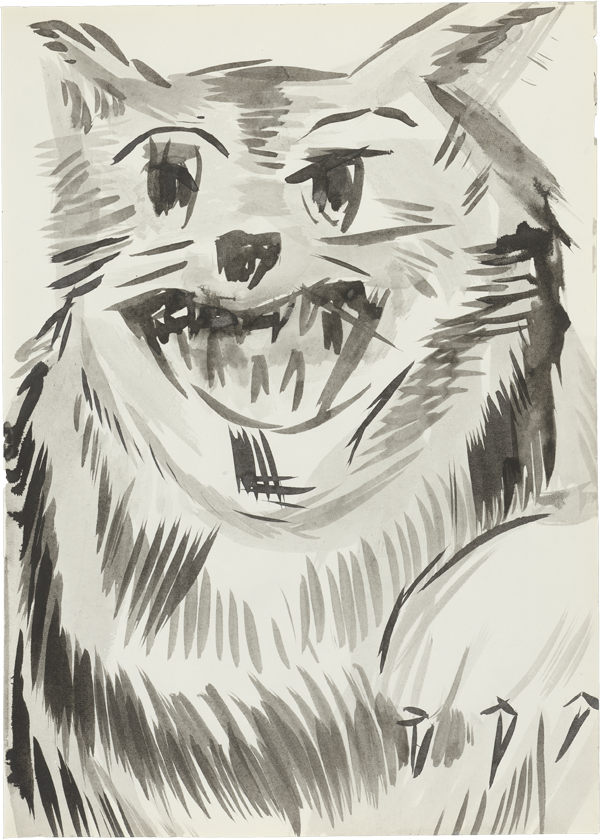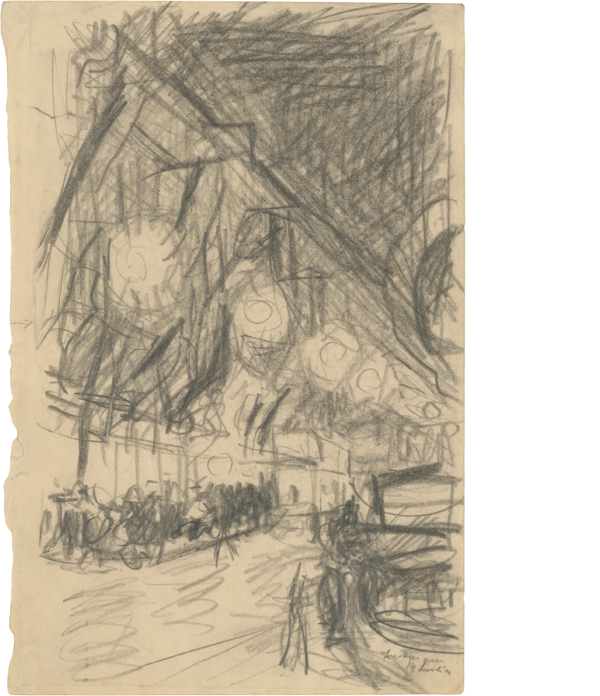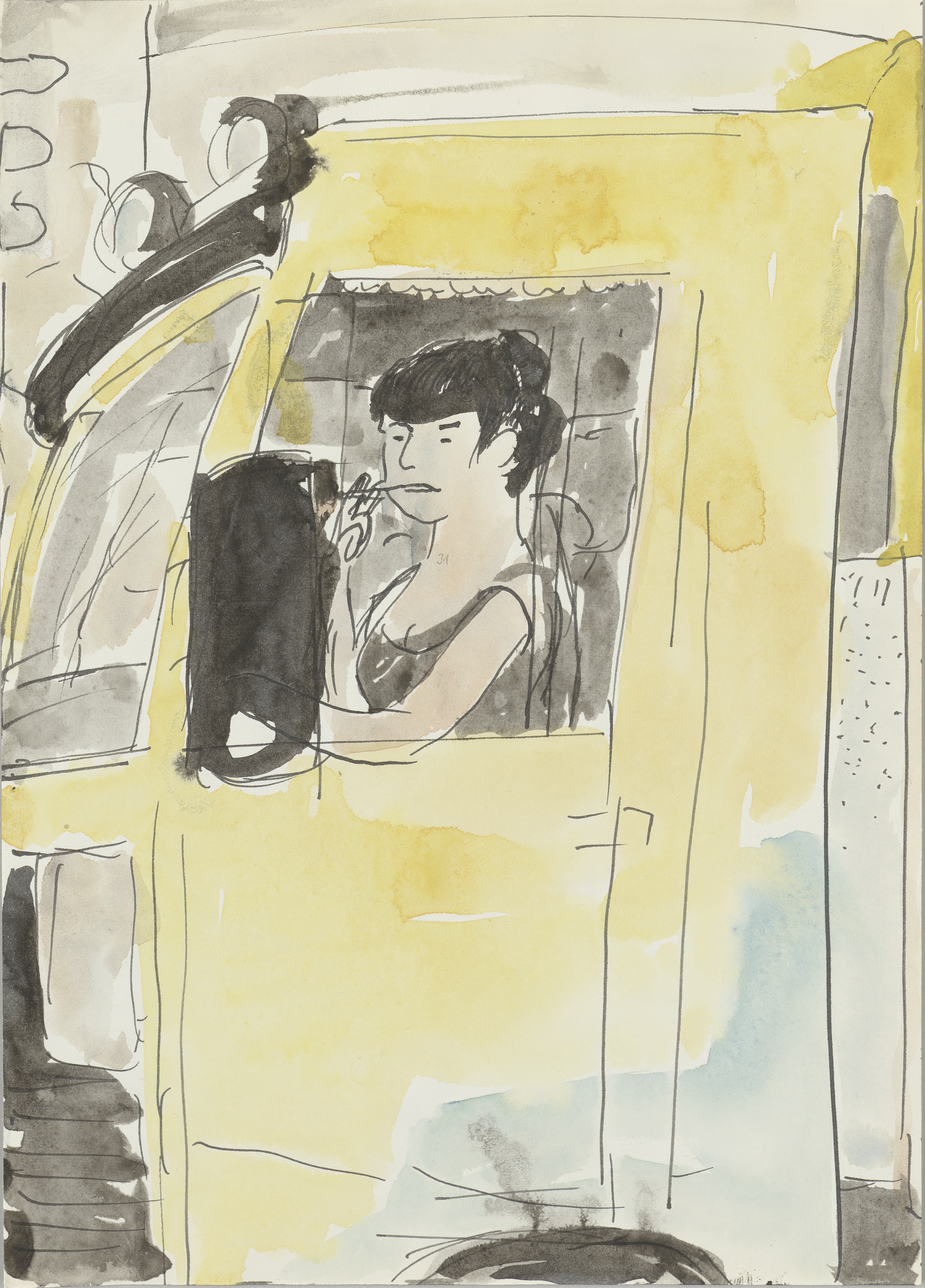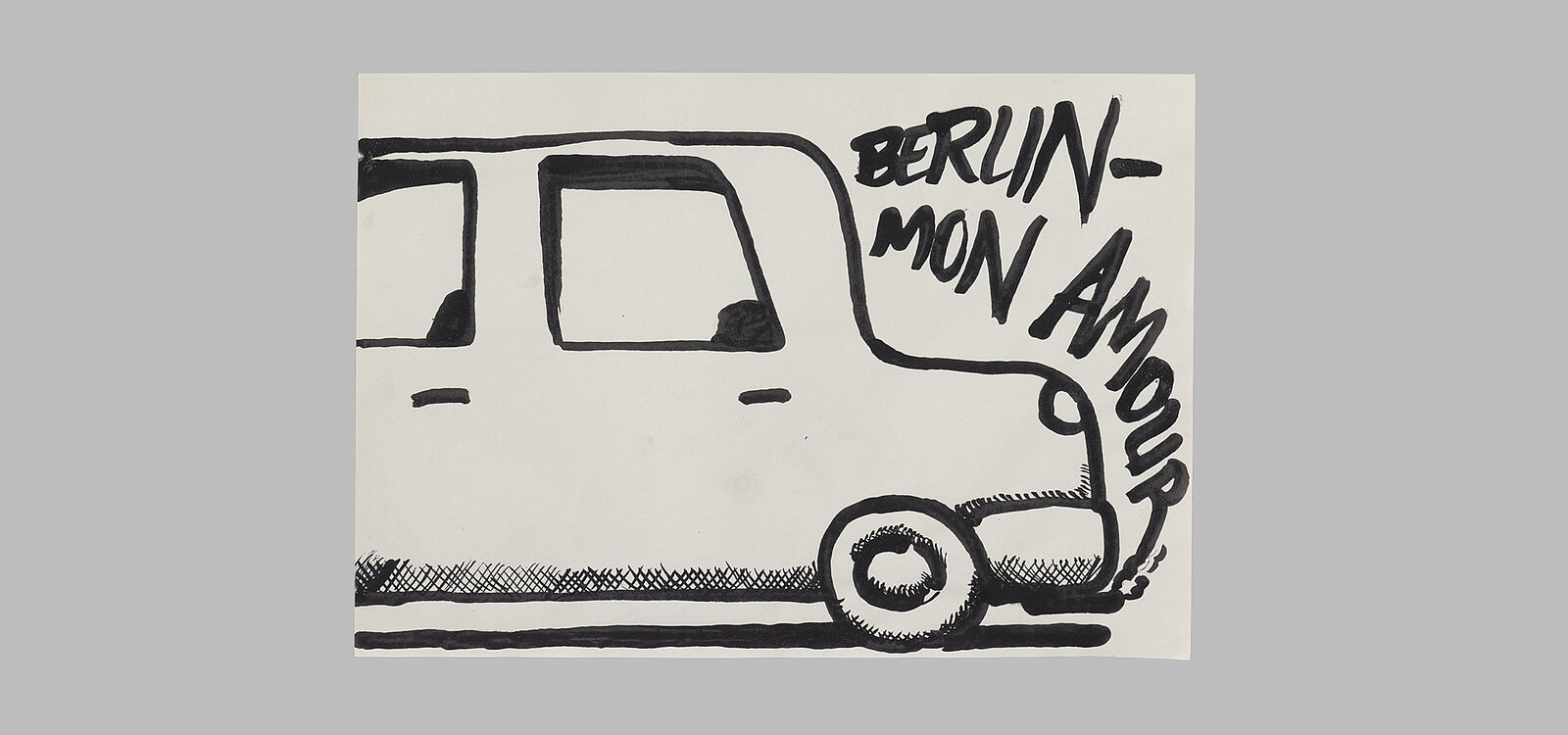Maximilian Kirmse – Berlin Mon Amour
08.02. – 05.05.2024
Zweifellos lässt sich die Sentenz Berlin Mon Amour nicht als unbeschwerte Liebeserklärung an eine Großstadt verstehen, deren rauer Lebenswirklichkeit man kaum schmeicheln kann. Sie ist ein Paradoxon, das einen provozierenden, erst bei genauerer Betrachtung sinnstiftenden Widerspruch in sich trägt. Berlin Mon Amour meint nicht das leichtlebige Lebensgefühl, das man mit anderen Metropolen verbindet.
Vielmehr beschreibt es die ureigene Lebenslust und unbändige Lebensenergie einer Stadt, deren Sinn für Freiheit und Weltoffenheit lähmender Kleingeistigkeit und Provinzialität entgegensteht. Diese Lebenslust und Lebensenergie sind es, die reaktionären Stillstand aussetzen und fortwährend Berlins vitalen Esprit des Neu- und Umdenkens beflügeln. Von diesem Lebenselixier angezogen, verzaubert es diejenigen, denen es gelingt, darin einzutauchen und sich auf ihr eigenes Liebesabenteuer mit der Spreemetropole einzulassen.


Genau von diesem eher lässigen Berliner Lebensrhythmus erzählen Maximilian Kirmses Bildwelten, ohne große Dramen zu bemühen oder absurde Motive erfinden zu müssen. Fern touristischer Großstadtphantasien, die vom alten glamourösen Westen, von schlafwandelnden Party-People in Mitte oder von coolen Hipstern in der gentrifizierten Stadtlandschaft am Prenzlauer Berg träumen, greifen die Zeichnungen und Malereien das unaufgeregte Leben in seinem Kiez auf.
Im Kontrast zu den genannten Klischees wirkt diese Alltäglichkeit umso verstörender, weil sie jedwede Sensationslust ins Leere laufen lässt und ihr vice versa den Spiegel vorhält. Dabei scheinen seine Szenen immer aus neutraler Distanz heraus beobachtet zu sein, sodass sie weder als „Milljöh“-Studien noch als Chronik einer Großstadt zu betrachten sind.


Ohne jeden Respekt vor akademischen Traditionen und den erdrückenden Fortschrittsgedanken des Avantgardeprinzips ignorierend, treffen in Maximilian Kirmses Werk völlig ungezwungen stilistische und ästhetische Elemente der „High“- und der „Low“-Kultur aufeinander und verbinden sich zu einem untrennbaren Konglomerat, das seine eigenwillige wie präzise Handschrift ausmacht. Zum Teil scheinen seine Motive der Comic-Kultur entsprungen zu sein, erinnern zugleich aber auch an primitivistische Bildwelten, die der Volkskunst entlehnt sein mögen. Nicht zuletzt leuchtet in seinen Tableaus, einem hypernervös, farblich überdrehten Blitzlichtgewitter nicht unähnlich, das Lebensgefühl eines Fin de Siècle auf. Diese Dissonanzen sind selbstverständlicher Teil des Lebensgefühls von Berlin Mon Amour.

Die kuratorische Idee von Berlin Mon Amour stellt Maximilian Kirmse aber auch als einen Künstler in der Tradition von Künstler*innen vor, die durch das 20. Jahrhundert hindurch Berlins coolem Charme erlegen sind und wie er ein eigenes Ding mit der Stadt am Laufen hatten und haben, um es etwas umgangssprachlich zu formulieren. Zu ihnen gehören unter anderen Max Beckmann, Georg Grosz, Jeanne Mammen, Werner Heldt, Christa Dichgans, K. H. Hödicke, Olaf Metzel und Anne Imhof. Insofern ist der Ausstellungstitel auch eine Hommage.
Die konzentrierte Auswahl einzelner Werke aus einer großen Fülle von Blättern mit Berlin-Bezug von der klassischen Moderne bis zur Gegenwart aus dem Bestand der Graphischen Sammlung München bestätigt, dass Berlin schon immer etwas mehr war als das, was man in einem spezifischen Augenblick zu kennen glaubte. Für sich betrachtet ist jedes der vorgestellten Werke ein sehr persönliches Bekenntnis zu Berlin. In ihrer Gesamtheit greifen sie einzelne Augenblicke der Stadtgeschichte heraus, die das facettenreiche Lebensgefühl spiegeln, welches sich mit der Spreemetropole verbinden lässt.


Berlin Mon Amour ist auch eine Reise der leisen Töne quer durch die Stadt, bei der das Alltägliche, Nebensächliche und Flüchtige ins Blickfeld rückt. In Verbindung mit den historischen Blättern wird Maximilian Kirmses Blick auf Berlin damit weniger zu einem Schlusspunkt als zu einem Auftakt in ein spannendes 21. Jahrhundert dieser Metropole.
Michael Hering
Maximilian Kirmse – Berlin Mon Amour
or
Of the Here and Now of the moment beyond the Tangible Present
08.02. – 05.05.2024
Clearly, the phrase Berlin Mon Amour cannot be understood as a light-hearted declaration of love to a big city whose harsh reality is scarcely something to boast about. It is a paradox that carries a provocative contradiction which only makes sense on closer inspection. Berlin Mon Amour refers not to that easy-going attitude to life associated with other metropolises.
Instead, it describes a city’s very own zest for life and unbridled vitality, whose sense of freedom and openness to the world stands in stark contrast to paralyzing pettiness and provincialism. It is this joie de vivre and vitality that defies reactionary stagnation and continues to inspire Berlin’s vital spirit of rethinking and reimagining. Drawn by this elixir of life, it enchants those who manage to immerse themselves in it and embark on their own adventure of love with this metropolis on the Spree.


Maximilian Kirmse’s images tell of precisely this more laid-back Berlin rhythm of life, without needing to resort to grand dramas or invent absurd motifs. Far removed from tourist fantasies of the glamorous old West, sleepwalking party people in Mitte or cool hipsters in the gentrified urban landscape of Prenzlauer Berg, his drawings and paintings capture the easygoing way of life in his neighborhood. Unlike the above clichés, this ordinariness is all the more disturbing because it leaves any sensationalism in the dust and, conversely, holds up a mirror to it. His scenes always seem to be observed from a neutral distance, meaning they can neither be seen as studies of “Milljöh” (i.e. milieu, in reference to Zille’s works) nor as a chronicle of a big city.


Without any respect for academic traditions and ignoring the oppressive idea of progress of the avant-garde principle, Maximilian Kirmse’s work brings together stylistic and aesthetic elements of “highbrow” and “lowbrow” culture in a completely unfettered way, combining them into an inseparable conglomerate that defines his both idiosyncratic and precise style.Some of his motifs appear lifted from comic culture while at the same time evoking primitivist imagery possibly borrowed from folk art. Last but not least, his tableaux, not unlike a hyper-nervous, colorful, over-excited thunderstorm of flashlights, illuminate a fin-de-siècle attitude to life. These dissonances are a natural part of Berlin Mon Amour’s outlook on life.
However, the curatorial idea of Berlin Mon Amour also presents Maximilian Kirmse as one in the tradition of those artists succumbing to Berlin’s cool charm throughout the 20th century who, like him, had and still have their “own thing” going on with the city, to use a somewhat colloquial expression. They include among others Max Beckmann, Georg Grosz, Jeanne Mammen, Werner Heldt, Christa Dichgans, K. H. Hödicke, Olaf Metzel und Anne Imhof. In this respect, the exhibition title is also an homage.
The tightly focused selection of individual pieces—drawn from a wealth of Berlin-related works from classical modernism to the present day from the holdings of the Graphische Sammlung München—confirms that Berlin has always been more than what we thought we knew at any given moment of time. Viewed in their own right, each of the works presented is a very personal tribute to Berlin. Taken as a whole, they highlight individual snapshots in the city’s history that reflect the multifaceted way of life that can be associated with the metropolis on the Spree.


Berlin Mon Amour is also a journey of quiet tones across the city, in which the everyday, the incidental and the fleeting come into focus. In conjunction with the historical illustrations, Maximilian Kirmse’s view of Berlin thus becomes not so much a conclusion as a prelude to an exciting 21st century for this metropolis.
Michael Hering

